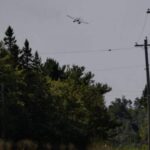The desperate search for missing Nova Scotia siblings entered its fourth agonizing week as emergency crews resumed ground operations Tuesday morning in the Dayspring area, southwest of Bridgewater. Six-year-old Ellie and four-year-old Wesley were last seen at their family home on July 16, prompting what has evolved into one of the most extensive missing persons investigations in recent provincial history.
“Every passing day weighs heavily on both the community and the search teams,” said RCMP Superintendent Craig Smith at yesterday’s press briefing. “But we remain resolutely committed to finding these children and bringing them home safely.”
The Nova Scotia RCMP has strategically recalibrated their search approach, concentrating efforts on several areas of interest identified through both public tips and sophisticated mapping analysis. The current phase involves systematic examination of dense woodland and waterways surrounding the family property, with specialized K-9 units deployed alongside tactical teams.
Community response has been overwhelming, with over 500 volunteers registering to assist through organized search parties. Local businesses have donated supplies, food, and accommodations for visiting search specialists, demonstrating what Bridgewater Mayor David Mitchell described as “the profound unity that emerges in times of crisis.”
The children’s parents, visibly exhausted at Monday’s community gathering, expressed gratitude for the unrelenting efforts. “The support from strangers has been our lifeline,” said Elizabeth Carter, the children’s mother. “We’re clinging to hope and ask everyone to keep looking, keep sharing their photos.”
Digital investigators continue analyzing surveillance footage from surrounding properties and businesses along potential routes the children might have traveled. This technological approach complements the physical search efforts and has expanded to include detailed examination of regional transportation networks.
Professional search consultant Margaret Waterson, who joined efforts last week, emphasized the methodical nature of the operation. “We’re employing probability mapping to prioritize areas based on historical patterns in similar cases. This isn’t random searching—it’s strategically directed and constantly adapting to new information.”
Weather conditions have complicated efforts, with recent rainfall altering terrain conditions and necessitating adjustments to search methodologies. However, the specialized equipment brought in from neighboring provinces has enhanced capabilities to navigate challenging environments.
The investigation has drawn national attention, with federal resources now supplementing provincial efforts. “Cases involving children mobilize extraordinary resources,” noted Justice Department spokesperson Michael Townsend. “Every available technological and human resource is being directed toward this priority.”
As daylight hours grow shorter with approaching autumn, search coordinators have implemented expanded operational windows, utilizing specialized lighting equipment to extend viable search times. Volunteer coordinator Sarah Langley confirmed that “rotation schedules ensure continuous ground coverage while preventing searcher fatigue.”
The psychological impact on the community remains profound. Local schools have implemented support systems for classmates of the missing children, while community counseling services report increased demand. “The uncertainty creates collective trauma,” explained Dr. Jennifer Hayes, clinical psychologist working with affected families. “Maintaining hope while preparing for difficult outcomes requires delicate emotional balance.”
As this heartbreaking situation continues unfolding, authorities urge anyone with information—no matter how seemingly insignificant—to contact the dedicated tip line immediately. In a case where every minute matters, could the crucial breakthrough be hidden in an overlooked detail from someone in the community who hasn’t yet come forward?
























